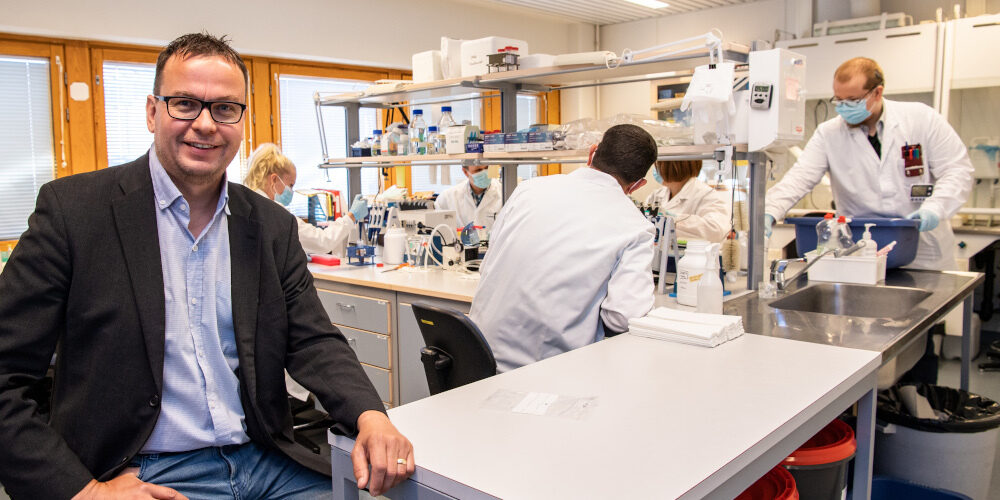
Leaders
You can find our home page by clicking this link.
Our AMD research group studies regulatory mechanisms of protein aggregation, as well as lysosomal and autophagy clearance in retinal pigment epithelial (RPE) cells. We also wish to understand the function of molecular chaperones in these clearance processes. We aim to find new autophagy linked therapies for AMD.
Our researchers and staff, as well as our collaborators around the globe, are all united by shared commitment to new scientific discovery on AMD. We seek to uncover and answer key questions in basic and preclinical research, allowing us to find novel therapies and cures for AMD for the benefit of tomorrow. Our vision is to connect talented young scientists with world-class leaders in AMD research and thereby promote discoveries that impact AMD care for the benefit of all.
See our group’s homepage for more information about AMD, our research, the team itself, what we’ve been doing, and how to contact us.
Cooperation
-
Our main aim is to reveal the context-dependent mechanisms behind fibrovascular tissue growth in proliferative diabetic retinopathy by studying cell-cell and cell-extracellular matrix communication in different three-dimensional in vitro and ex vivo models, as well as using omics and clinical data.
-
DNA damage; DNA repair; mutagenesis; carcinogenesis; breast cancer; glioblastoma; age-related macular degeneration; autophagy; senescence; mitochondria
-
Our main interests at the moment include cross-talks between inflammasomes, autophagy, mitochondria, and ER. These studies aim at drug development, and we are testing potential compounds that could rejuvenate the functionality of cells playing a major role in certain diseases. Our current clinical applications are mainly ocular diseases, such as age-related macular degeneration (AMD), corneal disorders, and diabetic retinopathy (DR).
-
Interests: Oxidative stress, Antioxidant defense, membrane transporters, mitochondrial function, retinal pigment epithelium, age-related macular degeneration, nanotherapy.
-
Our current research goals are to help define the molecular defects in retinal cells that are responsible for the pathology associated with AMD and the investigation of retinal proteasome. The proteasome proteolytic complex plays a fundamental role in processes essential for cell viability, such as cell cycle regulation, control of signal transduction and gene expression, and the degradation of oxidized and misfolded proteins. A recent focus of our lab has been to define conditions that provoke the upregulation of immunoproteasome in the central nervous system. Data derived from this experimental approach provide some indication that immunoproteasome’s function goes beyond its well-defined role in immune surveillance.
-
Our laboratory is interested in understanding the role of glia and glia-like cells (retinal pigmented epithelium) in ocular health and disease. We use genetically engineered mouse and spontaneous mutant rat models as tools to decipher functions of these cells in health and disease. The diseases we focus on are (1) Persistent Fetal Vasculature (PFV) and (2) Age-related Macular Degeneration (AMD).
-
My research has been focused on the role of inflammation in the pathogenesis of retinal degenerative and angiogenic diseases, including age-related macular degeneration (AMD), diabetic retinopathy (DR) and Retinitis Pigmentosa (RP). Although AMD, DR and RP are not classical inflammatory diseases, inflammation is known to play an important role in the initiation and progression of the diseases. We aim to understand how inflammation contributes to the aetiology of these diseases and to identify targets for therapeutic intervention.
-
The main research fields are drug delivery (controlled release, computational and cell-based methods for ADME research) and nanotechnology (biomaterial structures for drug and gene targeting and for 3D cell cultures).
-
The main research aim for the group is to develop novel stem cell based tools for the corneal and retinal repair through cell transplantation and ophthalmic in vitro tissue models
-
ATP, adenosine, CD73, photoreceptors, diabetic retinopathy, inflammation. Ocular ATP and adenosine have emerged as important regulators of retinal function, neurovascular coupling and blood flow distribution. However, current knowledge of regulatory pathways governing the duration and magnitude of purinergic signaling in a healthy and diseased eye remains scattered. Our recent data provide evidence for selective haemorrhage-related shifts in purine homeostasis in diabetic retinopathy eyes from the generation of anti-inflammatory adenosine towards a pro-inflammatory and angiogenic ATP-regenerating phenotype. Identifying the exact mechanisms by which the extensive network of membrane-associated and soluble enzymes regulates ocular nucleotide and nucleoside concentrations and further translation of purine-converting enzymes as potential therapeutic targets in the treatment of proliferative retinopathies with vitreous haemorrhage and other vascular and degenerative eye diseases will be an area of intense interest in the future.
-
Molecular Basis of Aging and Alzheimer's Disease
-
Research Topic: biology of aging and retinal diseases. Cellular and molecular pharmacology, especially for the Nrf2 factor and the RNA-binding ELAV proteins' roles in physio-pathological contexts.
-
Heart muscle can grow during most of the lifespan and it has significant capability of adaptation and plasticity. An increase in the work load (preload and/or afterload) and activity (heart rate) control the growth and properties of the muscle cells. The triggers for the adaptation are believed to be changes in the activities of ion channels acting in concert with complex calcium signaling mechanisms of the cells. These mechanisms form the basis of the extreme plasticity of cardiac muscle. Cardiomyocyte plasticity is manifested especially well during cardiac organogenesis and during the development of cardiac failure.
-

Our leader, Kai. 
Current slogan. 
Our group. 
You can find our co-operators all around the world. 
There’s strength in teamwork!
Keywords
Leaders
Senior Researchers
-

Szabolcs Felszeghy
Clinical LecturerInstitute of Dentistry, School of Medicine, Faculty of Health Sciences -
Juha Hyttinen
Project ResearcherInstitute of Clinical Medicine, School of Medicine, Faculty of Health Sciences -

Mika Reinisalo
Senior ResearcherSchool of Pharmacy, Faculty of Health Sciences -
Iswariya Sridevi Gurubaran
Visiting ResearcherInstitute of Clinical Medicine, School of Medicine, Faculty of Health Sciences
Doctoral Researchers
-
Ali Koskela
Grant-funded ResearcherInstitute of Clinical Medicine, School of Medicine, Faculty of Health Sciences -

Mikko Liukkonen
Visiting ResearcherInstitute of Clinical Medicine, School of Medicine, Faculty of Health Sciences -
Johanna Ruuth
Visiting ResearcherInstitute of Clinical Medicine, School of Medicine, Faculty of Health Sciences


